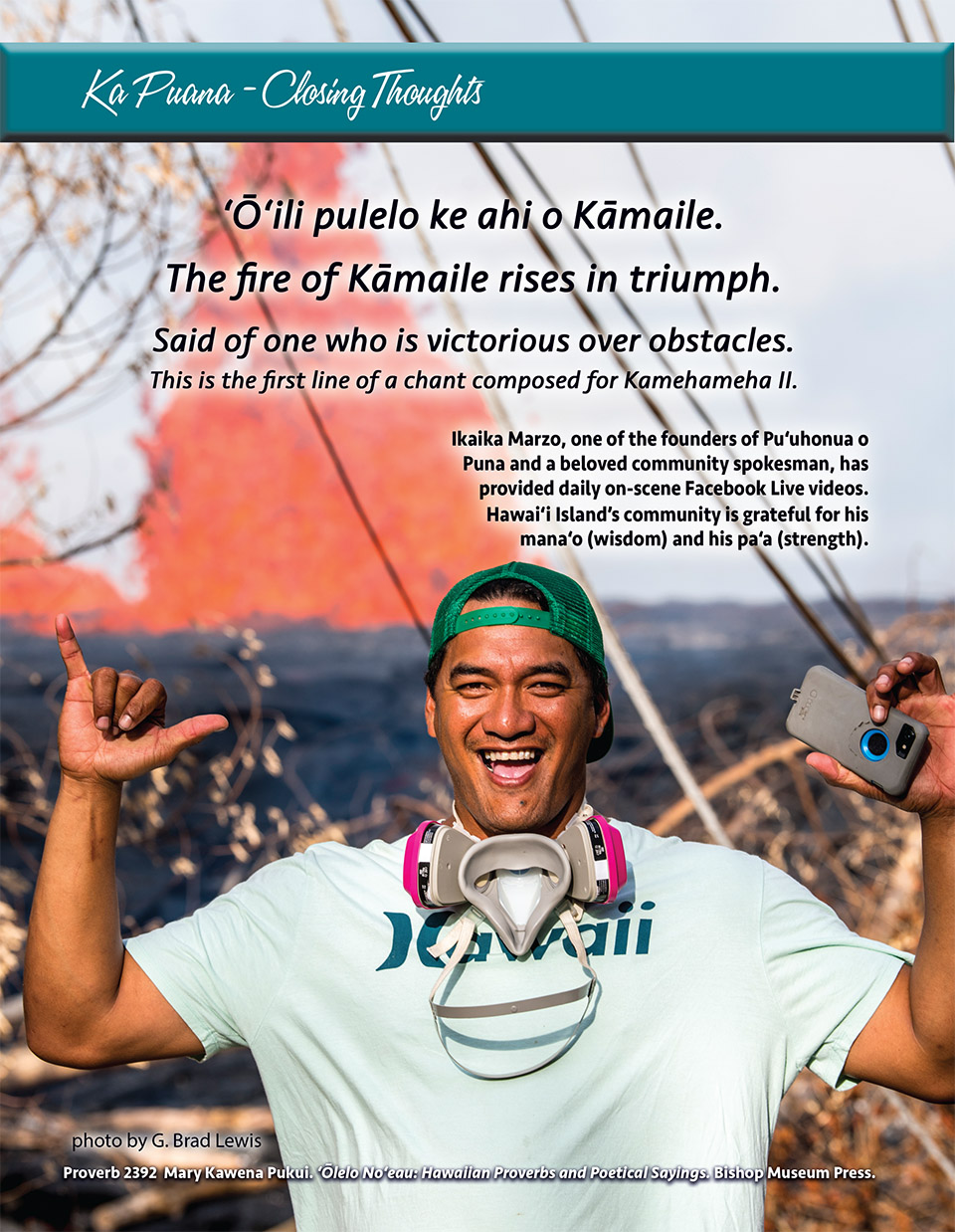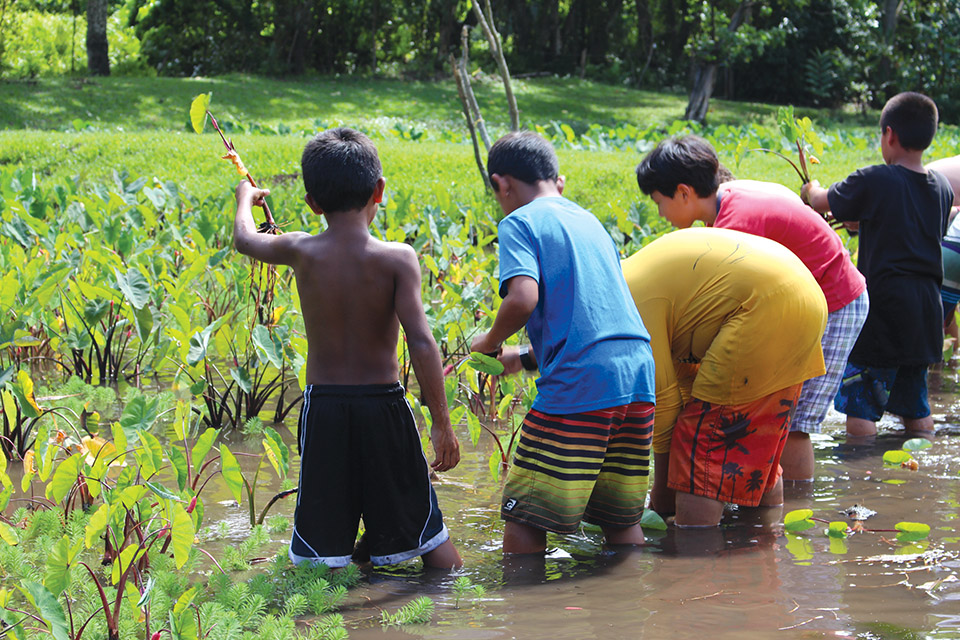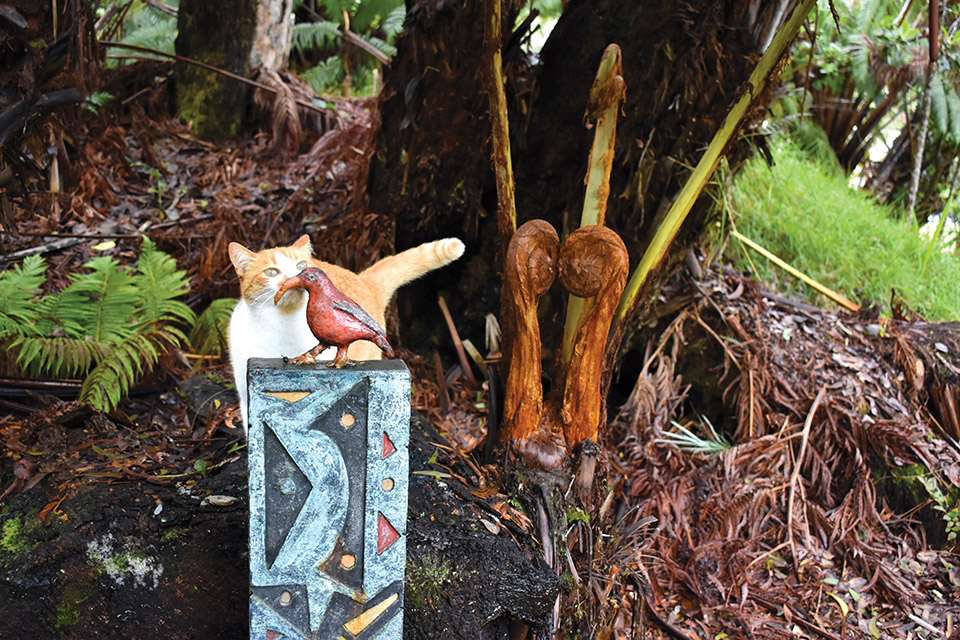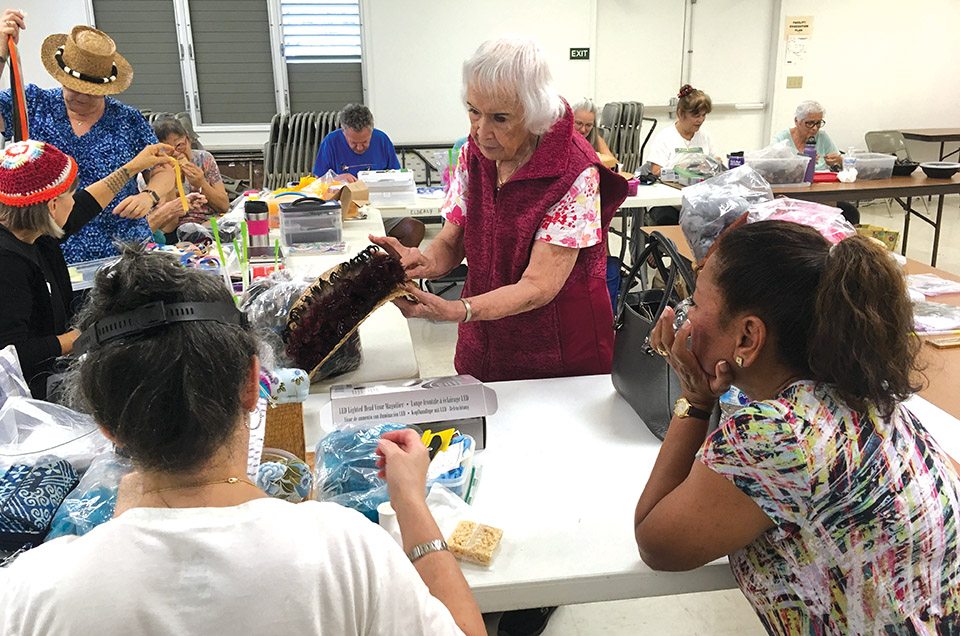
Aunty Doreen Henderson: Fascination with Feathers
85 Years of Perpetuating an Elegant, Native Hawaiian Craft
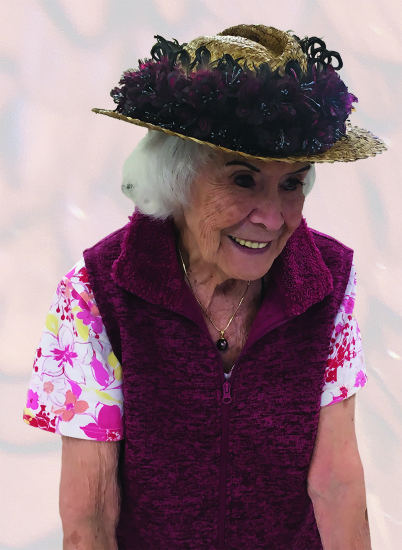
By Karen Valentine
With the confidence of a master craftsman who is still working and teaching at age 92, Master Kumu Doreen Henderson’s eagle eye marks each student’s feather work and doesn’t let them get away with anything but perfection. Her students, who have been gathering at the Kea‘au Community Center every Wednesday morning for decades, agree.
Even though they may be asked to take a project apart and start over, it’s obvious they respect Aunty Doreen as one of the leading experts and kumu (teacher) in the art of making Hawaiian feather lei or lei hulu, as well as other feathered objects such as kāhili. Her students are happy to work hard and do everything they can to help her with class logistics.
“If I get after them and it turns out well, they’ll do it the same way again,” she remarks. “And if they become a teacher, they will do it the way I do; it’s a reflection on me. A lot of them make lei and it really floors me. Good thing I’m not competing!”
“She is a perfectionist,” chimes in one student at the Wednesday class, smiling. “Aunty has the patience of a saint,” says another as each student painstakingly picks up tiny feathers and places them gingerly on a project in process.
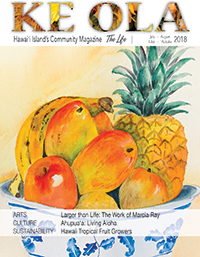
There are 13 levels of specific items, each subsequently more difficult, that a student must complete in order to graduate from Lei Hulu o Hilo, which Doreen Henderson founded. They start with a feather flower and a kāhili (feather standard, a symbol of royalty) before they tackle their first lei wili poepoe (feather tips lay against the cording and appear round when finished) and lei kāmoe (feathers are tied so they lay flat around the cording and the completed lei resembles a velvet rope) to adorn hats. Dense rows of tiny feathers are overlapped and sewn onto a felt backing, creating an exquisite flat or round lei that is smooth and soft to the touch, like the bird itself.
Her class is casual as students walk in and out on their own schedules. It is a mix of first timers and veterans, men and women. The veterans help the newbies. “I have a wide range of students. I start something and they carry on, jump in and help. I try to inspire, encourage, and push students,” she says.
“Sometimes I find lots of little errors in a student’s work. I want them to do it over until it’s corrected. If they say, ‘I’ll just leave it like that,’ I tell them, ‘No, it won’t look nice.’ You want to make the person feel good about their project. I want people to look at it and feel the movement of the design, not stop. You can actually read the lei, like the news.”
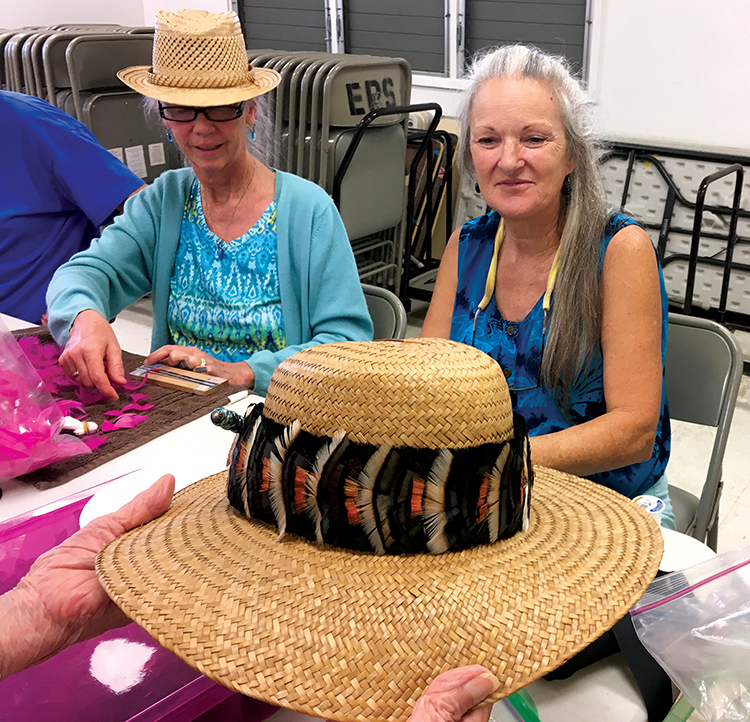
Due to her teaching career, her artistic excellence and heritage, Aunty Doreen has been selected numerous times to represent the native Hawaiian craft of creating garments and adornments with bird feathers—ka hana no‘eau i ka hulu—for exhibitions. It is a treasured native Hawaiian craft that has immense historical significance and therefore places the burden of responsibility on those teachers who aim to perpetuate it and feel that it should not be treated as a casual hobby.
The lineage of kumu hulu may be compared to the lineage of kumu hula, where knowledge is passed down from one generation to the next. Aunty Doreen has a genealogy that includes her cousin, the late Aunty Mary Lou Kekuewa—the most famous kumu of modern times—and Kekuewa’s student, the late Mary Kahihilani Kovich, both of Honolulu. Before her passing in 2008, Aunty Mary Lou would attend the Hilo hālauʻs graduation ceremonies.

Although Aunty Doreen, as well as her teachers and those who succeed them, are passing on the craft of Hawaiian feather work to many, it was traditionally considered “a semi-sacred privilege of a select few,” according to cultural historian and author Mary Kawena Pukui. Women of rank would often make their own lei hulu, hair combs and other more elaborate feather work to decorate formal gowns. Honolulu’s Bishop Museum has precious royal feather artifacts such as Princess Ruth Ke‘elikōlani’s personal feather kit. There were other items, especially kāhili, ‘ahu‘ula (feather capes), and helmets, which carried such sanctity that only certain people, usually male, could be instructed in their construction. Examples of these are also in the Bishop Museum collection, including King Kamehameha I’s feather cloak, made entirely of some 80,000 yellow feathers of the now-extinct mamo bird (black Hawaiian honey creeper). Other native and non-native bird feathers were also used, but none of these are available today.
Today’s craft uses materials easily available and which can be ordered, such as dyed goose or chicken feathers, peacock and pheasant feathers.
Feather work has been in Aunty Doreen’s consciousness since age seven, adding up to 85 years of fascination with feathers. As a child visiting her aunt and uncle’s house, she watched her uncle practice his craft of feather lei. “I knew from the time I was little what I wanted to do. I would watch him sew his feathers and he would give the lei to his friends.”
The feathers can be tiny and delicate, and her uncle had big hands, she says.
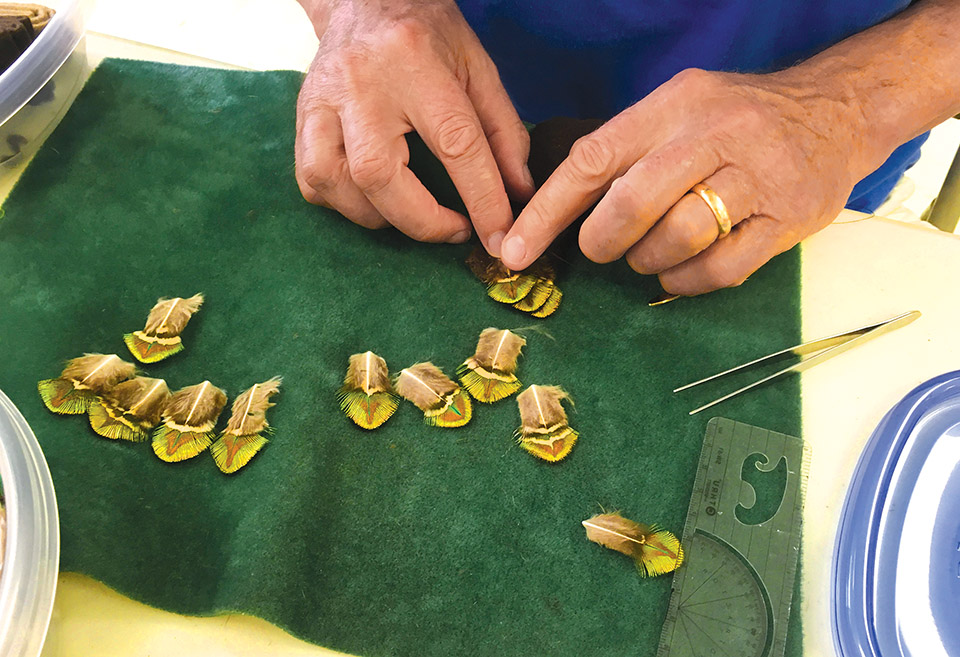
“He had a hard time picking up feathers. He let me help him because my hands were small. Every time my two sisters and I went there we had to climb into the chicken coop. He also had canaries. We worked hard picking up canary feathers and made it a contest; we also got to measure the feathers.”
That’s also where Doreen started to learn hula at age three, because her aunty had a piano. Hula would lead her to fulfilling her desire to make feather lei.
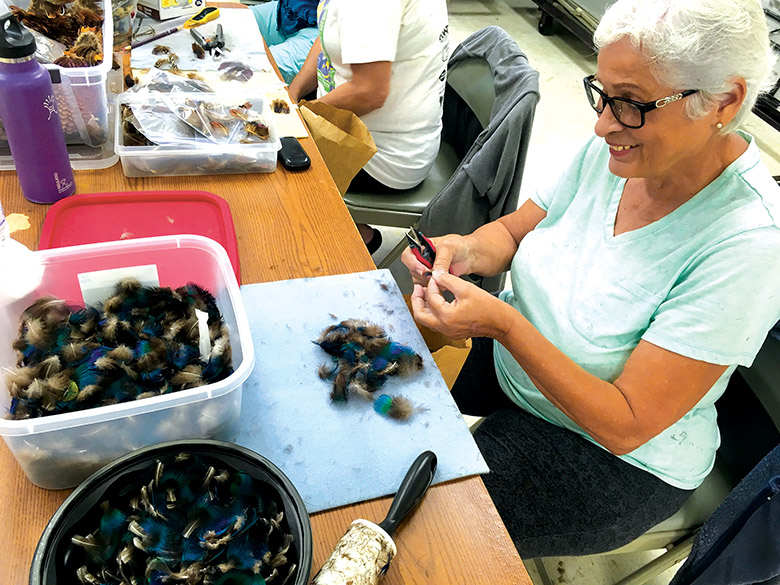
Aunty Doreen Henderson was born in Hilo in 1925 when her family property sat where the Grand Naniloa Hotel sits today. Her grandparents occupied the first house on Reed’s Bay and they lived in the caretaker’s cottage at the point. Her father, Leonard Rose, was a fisherman and her mother was with him in a boat when she went into labor. He had to finish catching a fish before he would take her to shore, she says.
When World War II broke out, the family moved to O‘ahu, where Doreen and her sisters finished school. Later she moved back to Hilo as an adult. Her ancestry is part Hawaiian.
“I made my first lei hulu at age 17. I tried learning on my own, until I met Mary Lou Kekuewa in Kapahulu. One of her students, Mary Kovich, became my teacher.”
Hawaiian cultural practices are as intertwined as a feather lei. Mary Kovich was a kumu hula in Kaimukī, where Doreen started dancing hula after graduation from Roosevelt High School.
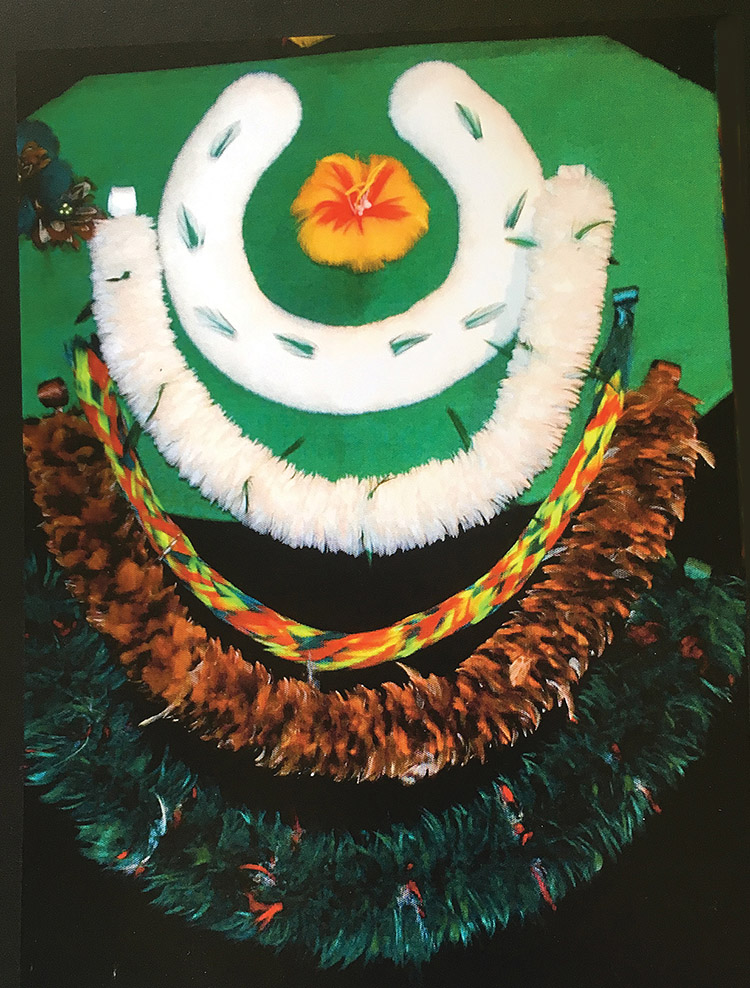
“We used feathers for dancing. Our hula class entertained at Hawai‘i Theater and the Princess Theater. We all had to make our own feather lei, either around the neck or maile style. We would make a ribbon lei with feather rosebuds every inch and it twirled around the maile. I had a special technique for holding a [feather hibiscus] flower open. When I did it, Aunty Mary said, ‘Who taught you that?’”
As in hula, feather work can be learned just by watching the kumu and others.
“I made feather work at home. I was really into feathers, looking for sparrows or whatever bird I could get ahold of, because I didn’t know where to buy them. I picked it up by watching the older girls sewing their feathers. I made mistakes and corrected myself. I wanted to make feather lei for the other girls to dance with. I had to make my own patterns. I found it hard. I couldn’t draw, but after I started feather work, I could see things like mountains and trees in the feather arrangements.”
Perhaps the greatest honor and compliment Aunty Doreen received was being asked to do all the feather work trim on a selection of royal gowns recreated from historical records for ‘Iolani Palace. When Queen Kapi‘olani and her sister-in-law, then Princess Lili‘uokalani, attended Queen Victoria’s Golden Jubilee in 1887, they wore colorful and elaborate gowns covered with feathers, perfectly in step with the Victorian tradition of the day as well as paying tribute to the Hawaiian tradition of reserving these special feather adornments for royalty. The Friends of ‘Iolani Palace commissioned historical-dress designer Iris Viacrusis of Hilo to recreate four of their outfits worn for state occasions—known only from vintage photos—in a yearlong project completed in 2017. [See Ke Ola, March/April 2018 issue]

Iris had met Aunty Doreen several years before when she was teaching her annual workshop at the Lyman Museum. He offered to design her dress to appear at the 50th anniversary of the Merrie Monarch Festival, where she was being honored as Queen from the very first Merrie Monarch Royal Court. He was impressed by the peacock feather collar she made in remembrance of Queen Kapi‘olani’s famous Peacock Gown, the replica of which she decorated for Iris three years later.
“I am glad to teach a teacher,” says Aunty Doreen, “because it expands the craft. I have students in Los Angeles, San Francisco, here, and on O‘ahu.” Many have also started teaching.
She is still making her own projects at age 92, including a royal helmet that’s in progress. She makes elaborate, feather-covered hats, pictures and even feather-covered stuffed animals. “I have to keep making lei because I keep giving them away. I’m fortunate; my eyes are still sharp. I wish I could live to 125, because there’s so much more I can learn, so much more I can do.” ❖
For more information: Doreen Henderson, Lei Hulu o Hilo, 808.982.5571
Photos by Karen Valentine
